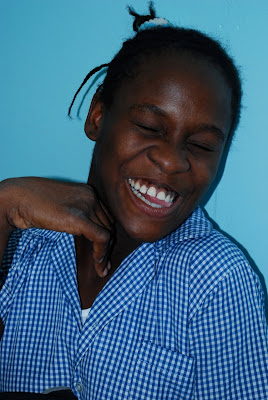Eleven volunteers from Cincinnati and Columbus Ohio converged on McKenna Farms for a working weekend at the therapy center The Red Thread has supported through Jacob's Fund over the past several years. What a remarkable experience!
Within minutes of arrival, the team took a tour of the original residence that now houses the administrative offices, waiting room and multiple clinical therapy rooms. In the yard outside the waiting room is a playground and homey seating area against a beautiful wooded backdrop, a space enjoyed by siblings and parents as they wait for their child’s therapy to be complete.
The original farmhouse now used as office and therapy space
Outdoor waiting area and playground
McKenna Farms director, Jessie
While we toured, Jessie, the director, shared some interesting facts about the farm and gave us a rather indepth lesson on hippotherapy, therapeutic riding and how these forms of treatment greatly benefit people with disabilities. Several hours was devoted to these discussions so we’ll do our best to summarize what we learned.
McKenna Farms is a 150-year-old historic site northwest of Atlanta in Paulding County near the famous Pickett's Run battlefield. The original farmhouse was used as a Civil War hospital and later restored back to a residence. Jessie was able to purchase the property in 2006—naming it after her beloved horse, McKenna—and began the lengthy process of converting it into a therapy farm that has been growing steadily ever since.
Currently, the facility serves approximately 200 clients, aged birth through 21, with varying neurological and physical disabilities (including Cerebral Palsy, Downs Syndrome, Autism, PDD, and various genetic disorders that cause developmental delays). Three occupational therapists, two physical therapists, one COTA (certified occupational therapist assistant), eight speech pathologists and 30 to 40 horse handlers provide hippotherapy, therapeutic riding and clinical therapy five days a week.
McKenna Farms has twelve full size therapy and four mini horses who occupy 15 acres. Many of their animals are rescues or have been acquired from people looking for a good home for a horse. All horses are hand selected by professionals since their work requires strong healthy animals that are able to carry unbalanced weight.
Some of the therapy horses
A 2,000 lb percheron appropriately named, TANK

Glenna getting up close and personal with STAR

One of the mini horses
This year, the farm was able to add an 80 x 120' indoor riding arena so children can continue their treatment with the horses year-round. The converted farmhouse includes multiple indoor therapy rooms with a variety of traditional therapy implements.
The new indoor riding arena
So exactly what is hippotherapy?
Derived from the Greek "hippos"—horse—hippotherapy literally means treatment or therapy with the aid of a horse. Not to be confused with riding lessons or therapeutic riding, hippotherapy is the process of administering physical, speech and occupational therapy to the patient by a trained therapist, utilizing the movements of a horse to directly influence the rider. Hippotherapy is best known to improve neurological function and sensory processing.
McKenna Farms patient during a therapeutic riding session
How does hippotherapy differ from therapeutic riding?
Therapeutic riding is often the next step when patients “graduate” from hippotherapy. It is a more independent style of riding that includes various therapeutic exercises and activities, allowing the rider more advanced physical, psychological and social development.
Therapeutic riding teaches riding skills to people with disabilities. Riders must learn to balance in the saddle, equally distribute their weight in each stirrup in order to sit properly during the horses' different gaits, and to use rein and leg aids correctly to communicate with the horse. Strength and endurance is gained by increasing the length of riding time and through the effective use of aides, i.e. hands, voice, legs and seat.
Therapeutic riding's greatest benefit is the gift of freedom. Riding is a freedom often taken for granted by able-bodied riders. To a person with a disability, it takes them from the confines of assorted assistive devices, such as walkers and wheelchairs. Riders become aware they can be mobile and independent of other people and mechanical aids: they are able to show their skills and abilities, leaving behind many of their personal limitations. This type of riding improves attention span and listening skills, enhancing the person's ability to integrate socially. A sense of pride can develop as horse skills increase, leading to greater self-esteem and self-confidence.
Now the more pressing question:
Why are these forms of treatment so effective?
Here are a few key factors that will help answer this question:
- When a person sits on the back of a moving horse, human pelvic movements are duplicated naturally, without effort on the rider's part, a great benefit for a person who cannot walk. As riders adjust to the changes in the horse’s gait and stride (as well as the uneven ground), these distinct movements help the rider improve his or her strength, balance, coordination and muscle control, while improving posture, range of motion, and stimulating the vestibular nervous and circulatory systems. In addition, the patient improves their sensory integration and organization as well.
- Hippotherapy and therapeutic riding are very efficient because all systems of the patient’s body can be engaged and "worked" simultaneously. For instance, all of the following activities are happening concurrently in a child’s body during a typical therapy session: the body is stabilizing itself on the horse; the ears are listening to the instructions from the therapist; the brain is processing, organizing and correctly recalling all instructions; the brain sends messages to the body to fulfill these instructions; the mouth forms the words necessary to guide the horse throughout the activity; and so on.
- Unlike more traditional forms of therapy in a clinical setting, children don't realize how hard their muscles and senses are working during the therapy because they are enjoying their time on the horse. They often experience reduced levels of anxiety when coming to the farm as opposed to a therapist’s office.
After the team got up to speed on McKenna Farms' therapy services, we got down to work.
Sources: American Hippotherapy Association,The Saddle Delight Center, HATS Niagara































































